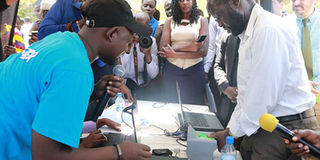Tricks to timely universal healthcare

Kisumu Governor Anyang Nyong'o launches the universal healthcare coverage pilot project in Seme on August 9, 2018. PHOTO | FILE | NATION MEDIA GROUP
What you need to know:
- Health professionals should be fully engaged to drive policy, not only as health users and health providers but also UHC ambassadors.
- UHC should be public-sector-led and tax-funded to, first, expand community health services to 100 per cent coverage of all sub-locations to reach all Kenyan communities.
The Universal Health Coverage programme was announced on December 12, 2017 as part of President Uhuru Kenyatta’s “Big Four” agenda.
A year later, on December 13, 2018, its pilot in four counties - Isiolo, Kisumu, Machakos and Nyeri - was launched at a ceremony graced by the World Health Organisation (WHO) director-general, Dr Tedros Adhanom Ghebreyesus.
The Kenya Vision 2030 delivery board has since hosted several conferences in the four counties to maintain the political momentum around UHC and generate and share ideas and lessons from the pilot.
But UHC seems to have been misunderstood from the onset. UHC refers to all having healthy lives and promoting the well-being of all.
The WHO definition of being healthy includes physical, mental and social well-being.
ACCESSIBILITY
To a large extent, health is made in the household and community. Hospitals should be looked at as places where health is restored, not made.
Besides building and supporting efficient health facilities, health systems must help people to know that a healthy life depends on sufficient sleep, earning a liveable income, proper eating habits, environmental safety, personal hygiene and safe drinking water.
Governments should create socioeconomic environments that promote healthy lives.
It is also critical that, as part of UHC, one should seek, access and afford health services when one gets sick. This implies that first-level health services must be close to everyone wherever they live.
Our community health services at the sub-location level, backed by dispensaries or health centres in every ward, would form solid points for upward referral of patients.
Dispensaries and health centres were built within a five-kilometre radius of nearly all citizens.
INADEQUATE CAPACITY
However, about 80 per cent of them are closed or not optimally functional as they were never staffed with appropriate health workers to offer primary-level care to citizens as needed.
Moreover, the dispensaries and health centres were not buttressed by community health services with adequately supported and motivated community health workers to aid in disease prevention and promoting health within communities as well as promptly identifying and assisting the sick to seek services.
Essentially, levels I and II health services have been dysfunctional despite an infrastructure and procurement push during the 2003-2007 Economic Stimulus Programme that saw dispensaries built but without a plan on how they would benefit the people.
The UHC launch reignited hope among health professionals that past mistakes will be avoided and promises will not remain empty while citizens die of diseases that could be prevented in the community or, at worst, easily managed within the lower levels of the healthcare system.
READINESS
But since the pilot began, UHC has become a mere catchphrase in conferences, leading to a crisis at hospital levels.
The unmet health demands for curative services over many years of neglect of the community health system, coupled with the waiver of hospital fees, have led to a 40-50 per cent upsurge of patients desperately scrambling for health interventions.
The government hospitals with doctors and nurses have become more congested.
Unfortunately, they were not ready with stocked commodities and drugs in anticipation of higher patient loads.
Neither were they added more doctors, nurses and other hospital staff to attend to the increased workload.
In this respect, UHC has resulted in more hospital-related deaths as hospitals such as Nyeri Provincial General Hospital and Jaramogi Oginga Odinga Referral and Teaching Hospital are unable to cope with the influx of patients.
REVIEW POLICY
The UHC plan must be redrafted. First, health professionals should be fully engaged to drive policy, not only as health users and health providers but also UHC ambassadors.
Importantly, UHC should be public-sector-led and tax-funded to, first, expand community health services to 100 per cent coverage of all sub-locations to reach all Kenyan communities.
Secondly, it will re-establish and strengthen referral processes between communities and lower-level health facilities and between lower-level health facilities and the higher-level hospitals and vice versa.
Thirdly, it will revamp efficiency in the delivery of curative services at the hospital level by providing the required workforce numbers and skills to all hospitals.
It would ensure that the unemployed 3,000 doctors and more thousands of nurses trained on taxpayer funds are absorbed to bridge staffing gaps and correct Kenya’s embarrassing health worker-to-population ratios to WHO standards.
That way, UHC will be achieved faster, more efficiently and sustainably.
Dr Oluga is the secretary-general of the Kenya Medical Practitioners, Pharmacists & Dentists Union; [email protected]. Prof Were is Kenya’s goodwill ambassador for Community Health Services; [email protected]




